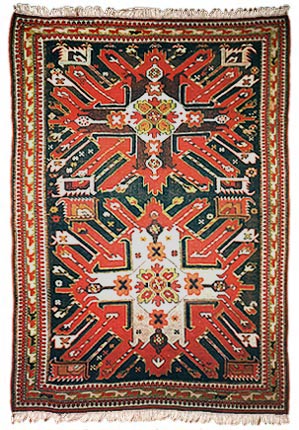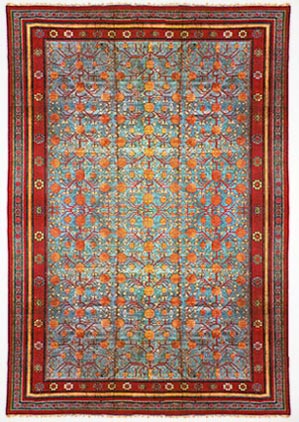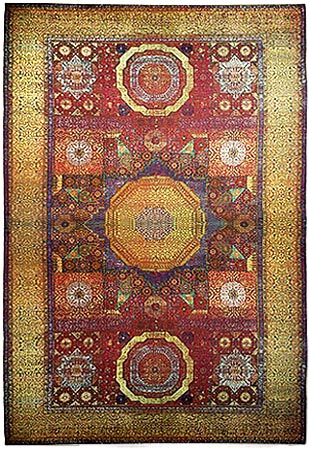RUG GUIDE
Rug Introduction 
The Illustrated Rug 
From Sheep To Rug 
Rug & Knot Types 
Rug Loom Types 
Basic Rug Care 
Stain Removal Guide 
Decorating Ideas 
Purchasing Guide 
Rug Names & Places 
Rug History Chart 
Glossary of Terms 
Presented by NEJAD RUGS:
THE ILLUSTRATED RUG - PART 2THE CAUCASUS (Caucasian) The Caucasus region - now comprised of several Soviet states - belonged to Persia until the early nineteenth century and is the home of diverse tribes of many separate languages, as well as two main religions — Christianity and Islam. The rugs produced here reflect the unsophisticated character of the people who live in this rugged mountainous area — bold & vigorous designs that feature bright colors and strong contrast - the overall effect being geometric, even primitive and of relatively modest proportions but remarkably uniform in style. As such no regulated weaving industry exists, and collector pieces date back only as far as the last half of the eighteenth century.
TIBET/NEPAL Although historical references pointing to the specific origins of Tibetan rugs are unclear, it is believed that carpet weaving in this Himalayan region is part of an age-old tradition practiced primarily for use in the home. Following China's suppression of Tibetan nationalism in 1959, thousands of Tibetans fled Tibet and settled in neighboring countries including Nepal. Shortly thereafter, carpet production began in Tibetan refugee camps, mainly situated in Nepal's Kathmandu (Katmandu) valley. By the mid-1970s, many carpets woven by Tibetans in exile were being exported to Europe. During the 1980s, Tibetan/Nepalese rugs have received increasing attention from the United States decorative market and exports to this country have steadily increased. The primitive, handcrafted look of these carpets, characterized by highly stylized patterns and tastefully orchestrated color schemes, has great appeal for the American consumer.
Originally produced as mats, door covers, saddle rugs, bed covers, and pillar rugs (made to fit around Buddhist temple columns), traditional Tibetan weavings generally reflect the significance of Buddhist religion in Tibetan culture and art. Various Chinese design elements were also adopted and transformed by the Tibetans as evidenced by the common use of the phoenix, dragon, and lotus symbols in traditional Tibetan carpets. Today, design schemes featured in Tibetan/Nepalese carpets (that is carpets woven by Tibetan refugees in Nepal) range from Westernized adaptations of traditional Tibetan motifs (e.g., branching floral designs and snow lions) to a vast medley of foreign and contemporary free-form patterns. Among the patterns adapted from non-Tibetan cultures are traditional Persian, Turkish, French, Bessarabian, and American southwest Indian. The contemporary-design rugs feature bold geometrics on open fields and adaptations of Art Deco designs. Whatever their ethnic origins, Tibetan/Nepalese patterns bespeak a compelling simplicity that is enhanced by a color spectrum spanning from the rich reds and blues to the softer lavenders and greys. In some cases, these hues are obtained through the use of vegetable dyes. Generally, the yarn used in Tibetan/Nepalese carpets is carded and spun by hand. This gives the face of these carpets a wonderful depth and richness achieved through the subtle variation of color and texture. Some rugs are woven exclusively with Tibetan wool which is characteristically flexible, strong, lustrous, and springy. The majority of the rugs woven are a blend of Tibetan and imported wool. Knot counts vary from 30 to 100 knots per square inch with the majority approximating 48 knots per square inch. The looms used today are larger than their native predecessors in order to meet the export demand for room-sized carpets. Tibetan weaving features a unique and ancient knotting technique which utilizes the "axis rod" (warp divider) and "gauge rod" (needle), tools not employed in other rug weaving countries. Tibetan/Nepalese carpets are increasingly coming into their own in the United States, stirring considerable excitement among American buyers. Indeed, they impart the rustic charm, characteristic of their traditional Tibetan counterparts, while featuring fashion-oriented colors and designs available in a full range of sizes. These bold, eclectic patterns and colorations heightened by a rich texture reveal a primitive sophistication unique to these carpets. SAMARKAND (Mongolia) Produced as far north and east as Mongolia, the rugs that fall into the category of Samarkand - named for the oldest-known city in Asia - incorporate features of both the Persian and Chinese rug, with design elements which include: circular-shaped medallions (used in various configurations) as well as flowers, trefoil leaves and pomegranates, but instead of a predominantly red background color, such as in Turkoman rugs, these rugs feature a lighter, brighter, color palette of soft blue, gray, and tan fields, with accents and border elements of yellows, blues, and bright reds.
Variations in design range from a single center medallion, to portions of the medallion woven into each corner surrounded by a border usually wider than on Chinese rugs and that may include a number of guard stripes. Thematic elements may include a pomegranate tree growing out of a vase on a singular color field, or a ground populated with Chinese butterflies, cranes, dragon(s), fish, or an endless knot motif. The rugs that fall into this category, named more for the style of the rug rather than it's place of origin, are typically hand woven of wool or silk using a Persian knot. EGYPT A Jewel Worthy of Royalty - The creation of the brilliant many-faceted 16th Century silk carpet (below), almost eighteen feet in length, and with a knot density of over 200 knots per square inch, and once the property of the House of Hapsburg, has been, over time, whimsically associated with a charming fairy tale. Once Upon A Time ... as the story goes, a thief was running off with a King's largest, most precious diamond when suddenly, the thief dropped the stone, and the diamond fell on a rock - shattering into pieces. Subsequently, the grieving monarch ordered that a carpet be woven to emulate the appearance of a landscape strewn with the fragments of his favorite stone.
Whatever it's inspiration, experts consider this Mamluk medallion carpet, woven in Cairo of finely-knotted silk in luminescent and shimmering colors, a supreme achievement of the art of Oriental rugmaking - and one of the world's finest carpets, and certainly one of a kind. The Illustrated Rug - Part 1 | The Illustrated Rug - Part 3 | Rugs of Afghanistan
|




